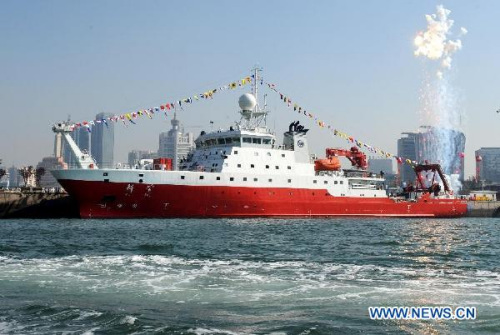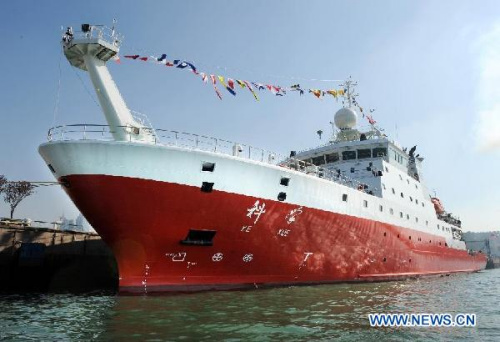
Photo taken on Sept. 29, 2012 shows the comprehensive research vessel, the Kexue (Science), in Qingdao, east China's Shandong Province. The 99.6-meter-long and 17.8-meter wide ship was put into service on Saturday. Powered by a podded electric propulsion system, the Kexue consumes less power, creates less noise and vibration, and is able to move at continuously varying speeds of up to 15 knots. (Xinhua/Li Ziheng)

Photo taken on Sept. 29, 2012 shows the comprehensive research vessel, the Kexue (Science), at Qingdao Olympic Sailing Center in Qingdao, east China's Shandong Province. The 99.6-meter-long and 17.8-meter wide ship was put into service on Saturday. Powered by a podded electric propulsion system, the Kexue consumes less power, creates less noise and vibration, and is able to move at continuously varying speeds of up to 15 knots. (Xinhua/Li Ziheng)
China's most sophisticated research vessel -- named Kexue, or Science -- was delivered to its operator on Saturday in Qingdao, a port city in eastern Shandong Province.
The 87.5-million-U.S. dollar ship, manufactured by the Wuchang Shipbuilding Industry Co., Ltd. based in Hubei Province, was handed over to the Institute of Oceanology, Chinese Academy of Sciences (IOCAS).
Weighing 4,711 tonnes, the vessel is 99.8 meters long and 17.8 meters wide. With a cruising capacity of 15,000 nautical miles and a top speed of 15 knots, it can travel with 80 members for 60 days.
Kexue features better stability and a larger laboratory space as well as having more manoeuvrabilty in comparison with other Chinese research vessels, said Sun Song, director of the IOCAS. He added that the vessel is among the world's most advanced research ships.
Capable of global voyages and all-day observations, the ship is seen as a moving laboratory on the sea.
It will serve as one of the key vessels for the country's oceanographic studies for the next 10 to 20 years, with world-leading facilities for scientific detection and experiments, Sun said.
Kexue is designed to conduct a wide range of tasks, such as water body detection, atmospheric exploration, deep-sea environment exploration and remote sensing information verification.
The construction of the ship began in 2010 and launched in November last year for trials.

Copyright ©1999-2011 Chinanews.com. All rights reserved.
Reproduction in whole or in part without permission is prohibited.